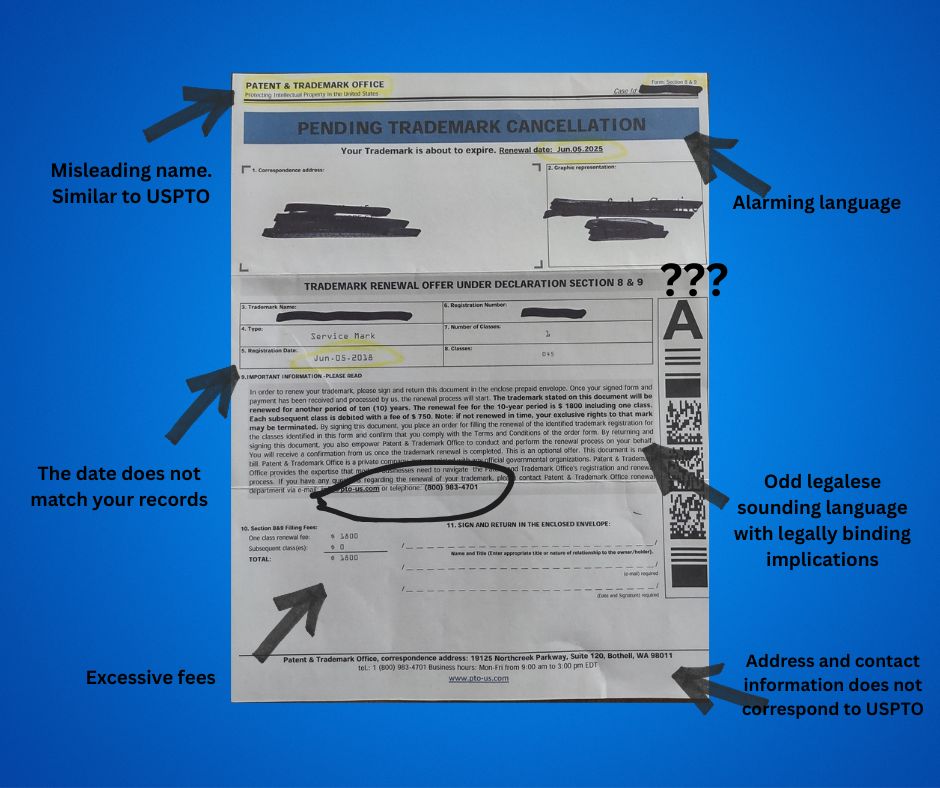As a business owner, you’re likely focused on growing your brand, expanding your client base, and protecting your intellectual property. But amid these priorities, there’s an unfortunate reality you may have already encountered: Trademark fraud.
Perhaps you have received an urgent, official, and concerning letter. The subject line screamed, “Pending Trademark Cancellation” or claimed to be an important notice about your intellectual property rights. The letter may resemble an invoice or appear to come from a government agency, with official-looking logos or names and language that creates a false sense of urgency. If you’ve filed for a trademark recently, such messages can cause real confusion—and even panic.
So, what’s going on?
These are part of a growing trend of trademark fraud targeting business owners, especially those newly registering trademarks or unfamiliar with the formal processes of the United States Patent and Trademark Office (USPTO).
Why You’re Being Targeted
When you or your attorney file a trademark application, your information becomes part of the public record. The USPTO publishes details such as your name, address, mark, and filing dates. Unfortunately, bad actors take advantage of this transparency. They scrape public databases for contact information and send misleading or fraudulent messages designed to trick you into paying for unnecessary—or completely fake—services.
According to the USPTO, trademark fraud is on the rise. Scammers impersonate government agencies or third-party companies and use fear tactics to compel action. These communications often include false deadlines, incorrect fees, and official-sounding names. They aim to get your money or signature on a service agreement you don’t need.
Common Scam: The Impersonation Tactic
One of the most frequent and deceptive types of fraud is the impersonation scam. This involves correspondence that appears to be from a government entity, often using names and logos that mimic the USPTO or other legitimate organizations.
These fake letters or emails may come from entities with names like:
- “Trademark Compliance Center”
- “U.S. Trademark Protection Agency”
- “Trademark Renewal Service”
- “Patent & Trademark Bureau”
- “Patent and Trademark Office” such as the example in this blog
None of these are real government offices. Scammers count on business owners not recognizing that the only legitimate U.S. government body handling trademarks is the United States Patent and Trademark Office (USPTO), whose official website ends in .gov (www.uspto.gov).

Scammers will sweep publicly available data to send letters like this to trademark owners. Consult with your attorney before taking action.
The documents might look very real, including your actual trademark number, your business name, and even the correct mark. But the goal is to manipulate you into paying fees that are not required—or to get you to sign over control of your trademark to a third party.
Trademark Fraud: Red Flags to Watch For
Here are a few signs that a trademark communication may be fraudulent:
- The message seems off. Pay attention to awkward grammar, misspelled words, or inconsistent formatting. Scammers often don’t write with the professionalism you’d expect from a government agency.
- Use of misleading names. Be cautious of names or logos that are similar to, but not the same as, official government offices. Remember: the USPTO is the only federal office responsible for trademarks.
- Inflated or unexpected fees. If you’ve already paid your filing fees, be wary of new charges. Trademark fraud notices often demand excessive payments for services you don’t need.
- Incorrect deadlines. Some scam letters will invent early deadlines to create pressure. Compare any dates you receive with the official USPTO timeline or check with your trademark attorney.
- Solicitations to switch representation. You might be urged to sign a document giving someone else control over your trademark or to designate a new agent. Be very careful—signing over your rights could lead to losing control of your mark.
How to Protect Yourself and Your Business IP
- Stay informed. Visit the USPTO website to learn more about legitimate communications and procedures.
- Be skeptical. If something doesn’t seem right, it probably isn’t. Trust your instincts.
- Consult your attorney. When in doubt, reach out to your attorney before taking action or making any payments. Always consult with Attorney Marcos E. Garciaacosta. Remember that our firm always answers your questions via 15 minutes free consultations by phone.
- Report scams. If you receive a suspicious communication, you can report it to the Federal Trade Commission (FTC) or the USPTO.
Final Thoughts: You Count With Marcos Law
Running a business means wearing many hats, and it can be easy to fall victim to fraud when your attention is split. Scammers prey on entrepreneurs’ ambition and lack of familiarity with legal processes. But with awareness and caution, you can avoid falling into these traps.
Protecting your intellectual property is critical to your brand’s success. Don’t let scammers take advantage of your hard work.
If you have questions, remember we are always a phone call or e-mail away.
Dial (480) 324-6378 or send us an e-mail at [email protected]
